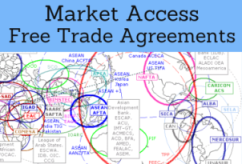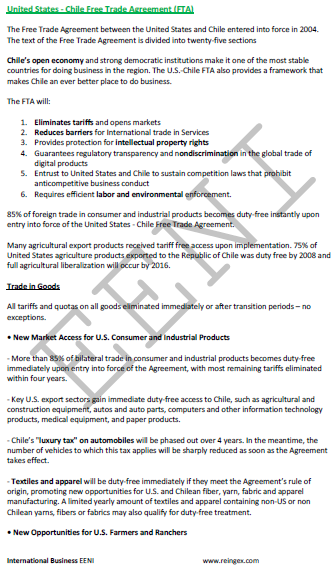U.S.-Chile Agreement

United States-Chile Free Trade Agreement
- Introduction to the Free Trade Agreement between the U.S. and Chile
- International Trade (Goods and Services) between the U.S. and Chile
- Benefits to the U.S. Agriculture
- Chile-U.S. Investment Flows
- Certificate of Origin
- Intellectual Property Rights


The Subject “United States-Chile FTA (Free Trade Agreement)” belongs to the following Online Programs taught by EENI Global Business School:
Masters: International Business, Foreign Trade.
Doctorate: American Business, World Trade.

Languages:  or
or  Estados Unidos
Estados Unidos  Etats-Unis.
Etats-Unis.


US-Chile Free Trade Agreement.
The Free Trade Agreement between the U.S. and Chile entered into force in 2004. The FTA:
- Eliminate the tariffs and open the markets
- Reduces the Technical Barriers to trade in services
- Provides an Intellectual Property Rights (IPR) protection
- Guarantees a regulatory transparency and non-discrimination in digital products
- Entrust to the U.S. and Chile to sustain competition laws that prohibit the anticompetitive business conducts
- The agreement requires a productive labour and environmental enforcement
85% of the foreign trade in consumer and industrial products becomes duty-free instantly upon entry into force of the U.S.-Chile Free Trade Agreement.
- Many agricultural export products received a tariff-free access upon the implementation
- 75% of the U.S. agriculture products exported to Chile was duty-free by 2008, and the full agricultural liberalization occur by 2016
Foreign Trade United States-Chile.
- In the seven years since the U.S.-Chile Free Trade Agreement (FTA) went into effect, the U.S. Exports to Chile augmented by 300%
- The main United States exports to Chile: machinery, mineral fuel, Petrol, vehicles, electrical machinery, and plastic
- The U.S. service exports to Chile: 2 billion dollars
- International Trade between the U.S. and Chile reached 18 billion dollars, an over 150% increase over the international trade levels before the U.S.-Chile Free Trade Agreement took effect
- The U.S. exports to Chile reached 10.9 billion dollars while the imports from Chile reached 7 billion dollars
- Chile was the 24th largest products export market of the U.S.
- Chile was the 38th largest imported goods supplier of the U.S.
- The U.S. remains the single largest foreign investor in Chile (24% of all the net foreign direct investment)
US-Chile Free Trade Agreement (FTA)

The Free Trade Agreement between Chile and the U.S. belongs to the Latin American and North American economic area of the Western Civilization.
(c) EENI Global Business School (1995-2024)
We do not use cookies
Top of this page



